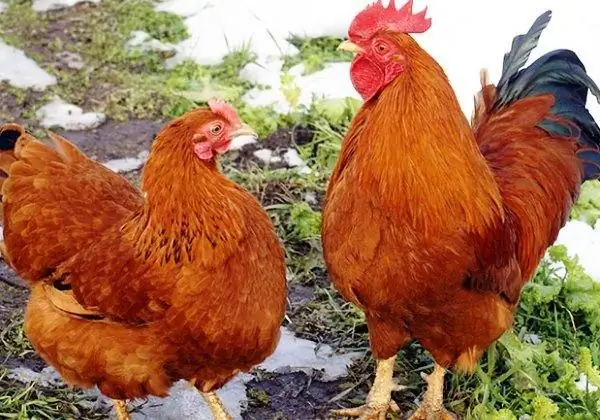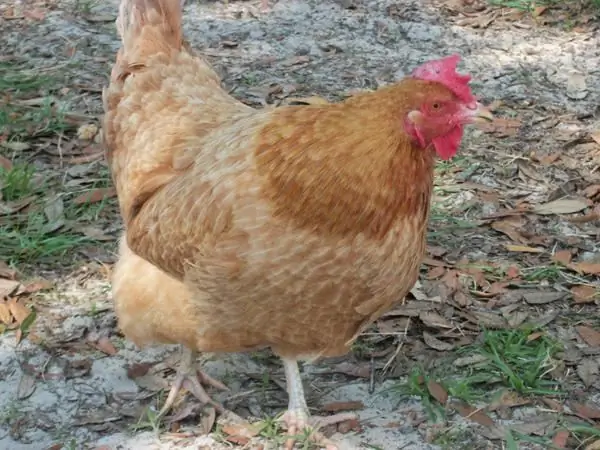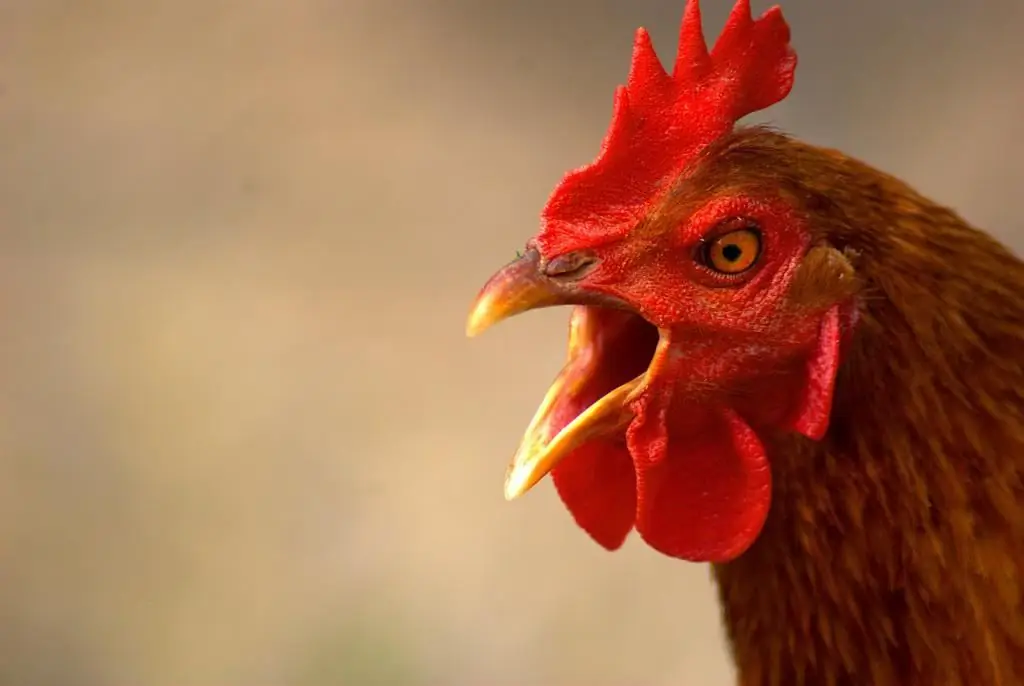2025 Author: Howard Calhoun | [email protected]. Last modified: 2025-01-24 13:10:47
Unfortunately, in Russian farms today, mainly foreign breeds of chickens and hybrids are bred. Such a bird really often has high productivity rates. But many owners of household plots have recently begun to give preference to domestic old breeds, which are not inferior to “imported” chickens in terms of egg production and weight gain. One of these varieties is Livenskaya.
History of the breed
For the first time, Liven chickens became famous at the beginning of the 20th century. The first to appreciate this breed, oddly enough, the British. The inhabitants of foggy Albion were attracted to this bird by the fact that it carried eggs with colored shells, and this was rare for that time. The English did not breed the Liven chickens themselves at that time. But eggs from the Oryol province were supplied to this country in huge quantities - millions of pieces a year.

Of course, such an interest of the British attracted the attention of domestic poultry farmers to the Liven chicken. In St. Petersburg, a special commission was even created,who was sent to the Oryol province to study local chickens. However, targeted work on the selection of this bird was not carried out at that time. After the revolution, in the 60s of the last century, the breeding of this chicken was considered inappropriate and it was destroyed everywhere. The breed was revived only in the 90s of the last century. Fortunately, its representatives have been preserved in some private courtyards.
Interesting fact
Until now, the Liven chicken is considered a rather rare breed. Many farmers have a rather vague idea about it. For example, in this article we will not be able to show the Liven vociferous chicken breed in the photo. That is what the owners of household plots sometimes mistakenly call it. Vociferous Liven chickens do not exist. The error in this case is due to the fact that this bird looks very similar to another old domestic breed - Yurlovskaya. It is this variety that is vociferous. The Yurlov cockerels sing loudly and continuously. Some breeders, due to the similarity of the exterior, even consider that these birds are the parent breed for Liven chickens. However, the voice of cotton cockerels, unlike Yurlov's, is quite ordinary, unremarkable.

Liven red chickens: general description
Purposeful selection of this bird, therefore, was practically not carried out. This breed arose, to a large extent spontaneously - thanks to the zeal of the peasants of the early 20th century, who wanted to increase the productivity of bred chickens by crossing their yard varieties.
Distinctive features of the Liven breed of chickens are, first of all:
- large, massive body with a horizontal stance;
- medium head;
- small comb (can be either leaf-shaped or rose-shaped);
- medium yellow beak;
- bright red oval earrings;
- thick neck;
- well developed mane;
- massive chest and back.
These chickens have chintz plumage. This color is typical for laying hens. Males of this breed are usually dark red in color.

The appearance of Liven chickens, therefore, are really quite spectacular. The culling of representatives of this breed is usually done on such grounds as a hunchbacked back and rare plumage. Also, not a very good indicator of blood purity is the different color of the metatarsus and beak. Of course, small chickens of this breed are also culled during selection, as well as those that carry too few eggs.
Productivity Metrics
Yurlovsky chickens are kept by homeowners mainly because of their beautiful voice. The Liven bird is bred specifically for meat and for eggs. The productivity indicators of this bird are higher than those of the Yurlovskaya. In a year, one Liven laying hen can lay up to 210 eggs (Yurlovskaya - 160). The weight of the chickens of this breed reaches 4-5 kg, cockerels - 6 kg (Yulovsky, respectively- 4 and 5 kg). The eggs of these chickens are simply huge - they can reach a weight of 100 grams.
In the courtyard, this bird can live up to 6 years. At the same time, every year laying hens reduce egg production by about 30 pcs. No special propensities for any chicken diseases have been identified in this breed. The death in the herd of these chickens is extremely rare.
Thus, judging by the productivity indicators, the Liven bird can be attributed to the meat and egg group of breeds. Basically, this is what determines the features of caring for her.
What you should know
Liven chicken is valued by farmers not only for the large size of the eggs. This breed has several other interesting features. Laying hens of this variety, for example, often lay two-yolk eggs. The latter are valuable in that they are superior to the usual in nutrition. The color of the shell in chickens of this breed is cream. The advantages of this bird include the fact that its eggs contain a lot of dense protein. This indicator in Liven chickens is greater than that of any other breed. That is why the eggs of this bird are considered the best in Russia today.

The peculiarities of the breed also include a high rate of individual variability of shell porosity. The quality of the eggs themselves in Liven chickens can vary significantly depending on the diet and season.
Character traits
The advantage of this breed is, among other things, its rather calm disposition. Liven cockerels usually do not fight with each other. However, toto representatives of other breeds, they can often be aggressive. Perhaps, in this case, the blood of Yurlov's parents affects. After all, this breed is distinguished not only by its sonorous voice. Yurlov chickens are also bred as fighting ones.
Liven chickens are thus usually kept in separate poultry houses. This prevents fights.
Bird shed
The Liven chicken is not bred industrially. It is believed that it is just perfect for keeping it in farmsteads. This bird is very unpretentious, independent and not voracious. Unlike the same Yurlov chickens, the Liven ones endure the cold quite well. The plumage of this bird is quite dense. Thus, it is possible to breed it both in the Urals and in Siberia.
Although the Liven chintz breed is quite unpretentious, some rules for its maintenance should still be observed. The barn for this bird should be spacious enough and dry. The presence of drafts in the room where Liven chickens will be bred is unacceptable. Of course, as for any other breed, the barn for this bird should be insulated. On the floor you need to lay a thick layer of straw or sawdust. But it is not necessary to insulate the house too much for this breed. Even in the winter season, the Liven laying hens practically do not reduce egg production.

Perches for these chickens are best placed lower. The weight of Liven chintz is significant. And it will be difficult for them to climb too high. The same goes for nests. perchesusually located at a height of 70-80 cm. Nests can also be filled next to them. The latter, among other things, should also be spacious enough.
Aviary
Next to the barn for Livny chickens, a paddock should be arranged. This bird actually loves space very much. And so walking in the fresh air will only benefit her. Many farmers have noticed that laying hens of this breed improve egg production if they eat a lot of green grass. It is not necessary to equip a too high fence around the aviary. Fortunately, these chickens are not particularly hyperactive.
Liven chickens: care, feeding
The diet for poultry of this breed is usually developed the same as for any other meat and egg. Liven chickens can be fed 2-3 times a day. In this case, both concentrates (grain, bran) and vegetable mixers should be used. The latter are usually offered to chickens once a day. You can include in the diet of the Liven bird and special compound feeds. When the content is on the usual home "menu", you should additionally use premixes.
You can't overfeed the Liven chicken. Otherwise, she may reduce egg production.
Farmers voice
Reviews about this breed on the Web are mostly good. Most farmers praise this breed as highly productive in terms of both egg production and weight gain. Some homeowners, for example, note the fact that with proper care, laying hens of this breed can lay not 200, but up to 300 eggs per year.
To someThe disadvantages of the Liven bird include only its rarity. Finding a hatching egg of the breed is quite difficult.

Breeding
Photos and reviews of the Liven chintz chicken breed presented in the article allow us to judge it as actually quite spectacular in appearance and at the same time productive. There are good reviews about this bird in terms of the possibility of increasing the livestock.
Unlike the same Yurlov chickens, Liven ones are excellent brood hens. They hatch the chickens on their own. These chickens reach puberty much later than many other breeds - at the age of one. This, of course, can be attributed to some of the shortcomings of the Liven bird. As noted, the best hens of this breed incubate their eggs in the spring.
Of course, if desired, the chicks of this bird can be incubated. Breeding Liven chickens in this case is carried out according to standard technology. Hatched chickens are fed with chopped eggs, millet and cottage cheese. You can also use Start food for meat breeds.
Cons
Liven chickens grow quite slowly. This also, of course, can be attributed to some of the shortcomings of the breed.
Sometimes Liven chicks don't fledge well. Bald spots may be noticeable on their body. At the same time, other individuals usually quickly notice such a defect and begin to peck at the body of the “comrade”. A farmer who breeds Liven chickens should take a closer look at this. A high percentage of pecking is also a disadvantage of the breed.
Cockerels of thisfemale varieties never hit. But the Liven chickens of the “cavalier”, if he is not able to stand up for himself, oddly enough, they can peck to death. When laying hens show aggressive behavior, the cockerel in the herd, of course, should be replaced.

Instead of a conclusion
So, we hope that the review of Liven chintz chickens presented above in the article allowed the reader to get to know and appreciate this wonderful old domestic breed. This bird is really unpretentious and productive. Her eggs, with proper care, have completely unique qualities.
Recommended:
Kuban red breed of chickens: reviews, description, characteristics, content features, feeding and care

According to numerous reviews, the breed of Kuban red chickens has both certain pluses and minuses. A distinctive feature of the bird is good egg production, which remains approximately at the same level, regardless of seasonal factors
Kuchinsky anniversary chickens. Meat chickens. Egg breeds of chickens

Poultry farming has been extremely popular with our peasants since ancient times. Chickens and ducks required little care, in the summer they found food on their own, and the eggs and meat received from them were a valuable source of protein, which was so necessary in a difficult rural lifestyle
Sussex (breed of chickens): features, characteristics and description

Among all breeds of chickens there are special, elegant, well-fed and excellent laying hens. This is a Sussex - a breed bred in England. The name of the chickens refers to the county where they were bred. The breed has various subspecies, but each of them occupies a worthy place in the poultry industry. If you choose a breed of chickens for home breeding, then the birds of this breed will definitely not disappoint their owners
Breed of chickens Loman Brown: description, characteristics and features

Kury Loman Brown is an artificially bred breed. The purpose of the work of breeders was to develop a cross with increased egg production and well adapted to a variety of climatic conditions. The breed appeared in 1970 and almost immediately gained recognition as one of the most successful crosses
Cannibalism in chickens: causes and treatment. Features of keeping chickens

Cannibalism in chickens is a rather creepy sight that can scare even an experienced farmer. Of course, this brings serious losses to any economy. Therefore, it is especially important to know how to act in such a situation in order to quickly solve the problem

